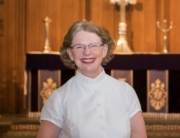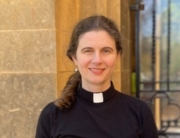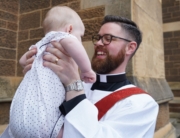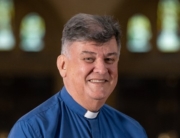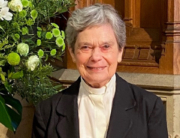Signs of Sacrament
A Sermon by The Very Rev’d Frank Nelson
Genesis 37:1-4, 12-28, Psalm 105:1-6, Romans 10:4-15, Matthew 14:22-36
I’ve talked before about the use of metaphor in our understanding of the Bible, and the power metaphor has of drawing us into an image which promotes a deeper understanding – both of life in the image, and of the implications for daily living. Without too much stretch of the imagination these implications drawn from metaphor can be understood as sacramental – the obvious visible symbol stands for something much richer, deeper and often of God. This morning I invite you into that metaphor space again and offer some thoughts on current and biblical metaphors.
Many of us, I suspect, will be familiar with the Andrew Lloyd Webber rock-opera “Joseph and the Amazing Technicolor Dreamcoat’. It tells the story of Joseph – son of Jacob and brother to eleven. This morning’s snippet from Genesis is part of the story on which the opera was based. It marks the beginning of another long saga with all the twists and turns that the writers of Genesis so relished. Whatever we make of the ‘robe with sleeves’, as it is described in Genesis, the message screamed out “Look at me, Look at me!” Hardly the wisest gift of a father to one of his youngest sons, it certainly provoked reaction from the brothers. The story-teller skilfully weaves the robe or cloak into the over-arching story of God’s care for God’s people, and what is called salvation history. If Joseph had not been singled out with the gift of the robe; if his annoyed jealous brothers had not sold him into slavery; if Joseph had not been able to interpret dreams and worm his way back into favour … the story goes on until we get to Moses, Exodus and the long journey to the Promised Land.
Earlier in the week we kept the Feast of the Transfiguration. It tells of a mountain-top experience where Jesus is transfigured in a cloud and claimed by God as God’s Son – one to whom the disciples should pay attention. Cloud and wind, lightning and storm in the Bible trigger thoughts of the presence of God, known as the ‘shekina’ – glory, and some form of communication between God and humankind. Such was the experience of Moses and later Elijah, and now Peter, James and John who accompanied Jesus up the mountain.
That cloud on the mountain of Transfiguration is seared into my mind by another cloud – the mushroom-shaped cloud of the atomic explosion over Hiroshima. Seventy-five years ago, that cloud tells of unspeakable suffering and countless thousands of deaths which happened quite literally in a flash. It speaks too of decades of fear and mistrust between super-powers, of atomic testing in South Australia, of cover-ups and deliberate lies, of terrible and ongoing suffering from radiation disease, of an end to a war. Ironically, and tragically, on the day before this year’s Feast of Transfiguration and the seventy-fifth anniversary of Hiroshima, another mushroom-cloud spumed into the air, this time above Beirut. The fallout from that continues. The mushroom cloud of Hiroshima gave birth to a powerful, and beautiful, symbol, one initiated by the young girl Sadako Sasaki who died in 1955 of leukemia – also known as the ‘atom bomb disease’. Her symbol was the origami folded paper peace crane.
Today’s Gospel passage invites us to consider another mountain experience – this time Jesus climbing up, not to be transfigured, but to find renewal in the silence and aloneness. After a busy day that mountain experience offered rest, quietness, centering, prayer. From that still point Jesus sets out down the mountain to join his friends in the boat. I don’t think it is helpful to try and work out if or how Jesus literally walked on the water. Go with the metaphor. Or perhaps better, the metaphors, including the storm on the lake and the little boat with its cargo of terrified disciples.
For people shaped by a desert-history, large expanses of water were frightening places. Sudden storms and strong wind, waves which could easily, and frequently did, overwhelm little boats with associated loss of life, were terrifying. If we know our Bible well we will remember the opening verses of Genesis and the Spirit of God, the wind of God, brooding, hovering over the waters of chaos, bringing peace and order, land, sky and sea – ultimately creation as we know it. It is not the Spirit of God this time, but Jesus with his words – in Greek ego eimi – It is I, I am – that brings peace to the disciples. Those words take us to another incident and image – the burning bush and God’s words to Moses, “I am.”
Before we leave this incident, look above your heads. Notice the ceiling, the inside of the roof, of the Cathedral. What does it remind you of? Not for nothing is the church sometimes referred to as the ark of God, the place, like Noah’s ark, where God’s people are held in the palm of God’s hand.
Jesus, centred in the stillness that comes from time alone with God on the mountain, brings peace to frightened disciples. As long as he focuses on Jesus, Peter finds he too can walk on the water. Is there something in that for us today, caught up as we are in the anxiety of a virus that can be named but not seen?
And so to two contemporary images which speak of God’s love and, particularly, our love for our neighbour. I refer to the now ubiquitous bottle of hand sanitiser, and, what will, I am sure, become common even in South Australia, the face mask. There has been debate in some church circles cautioning people not to let the sanitising of hands by the priest become a sort of sacramental act and new liturgical rite. I disagree with that sentiment. I’d like to invite you to think of the cleansing of our hands using hand sanitiser as very much a sacramental act. As I enter the Cathedral, or prepare to offer the precious Body of Christ to people, I press down the little lever which releases the precious balm into my hands. The act of cleansing, of massaging, my hands is a prayerful act that reminds me I do this for you – my neighbour, even as you do it for me, your neighbour. The same can be true in the wearing of a face mask, which those of us giving out communion will do from today. It is with your health – the same Greek word can be translated salvation – in mind that I do so. As such it becomes not just something that a premier or government official advises, even commands, but a willing offering by me to you.
Just yesterday was added another sacramental – or perhaps better, sacrificial – act to our church-going and communal congregational life. The debate around the safety of choirs and singing has been raging for six months now. Following advice received yesterday we have suspended congregational singing for the time being. As the Cathedral Choir sings the hymns and mass setting this morning, allow yourself to enter into the beauty of God’s holiness. Use your silence as a prayer for others – for professional musicians and singers who have been silenced by the virus, for those who are sick, for those who put their lives and those of their families on the line for the well-being of others, for those who have died or who will die as a result of contracting Covid-19. Our not singing seems a small price to play for the health and well-being of us all.
And for those who are fearful of the future, and I include myself in that number, let us hear again the words of Jesus when he approached the little boat tossed to and fro by the storm: “Take heart, it is I; do not be afraid.”

